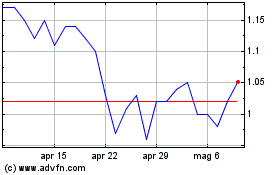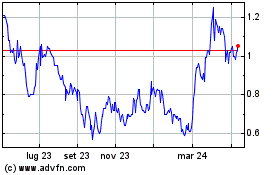$10 billion deal for Goldcorp intensifies consolidation wave as
gold supply dwindles
By Alistair MacDonald and Jacquie McNish
This article is being republished as part of our daily
reproduction of WSJ.com articles that also appeared in the U.S.
print edition of The Wall Street Journal (January 15, 2019).
Newmont Mining Corp. agreed to buy rival Canadian gold producer
Goldcorp Inc. in a $10 billion, all-stock deal, creating the
world's largest gold miner.
The deal intensifies a consolidation wave triggered in part by
languishing prices and dwindling supplies of easy-to-find gold, and
comes on the heels of another gold-mining blockbuster: Barrick Gold
Corp.'s agreement in September to buy Randgold Resources for $6
billion in an all-share merger.
If Newmont consummates the Goldcorp deal, the new company, set
to be based in Denver, will surpass Toronto-headquartered Barrick
-- its longtime rival -- in production, a key industry metric.
Newmont and Barrick have circled each other for years and had toyed
with a combination of their own in 2014.
Newmont, the U.S.'s largest miner measured by market
capitalization, said it would acquire each Goldcorp share for 0.328
of its own stock. That represents a 17% premium to the Canadian
company's 20-day volume weighted average share prices.
The depletion of high-grade global gold reserves, and the
resulting increase in extraction costs, has pushed miners to seek
cost efficiencies and to buy other companies' to land their
reserves.
Such moves have become more pressing because exploration for new
reserves has slowed dramatically after gold prices fell following a
boom that peaked in 2001.
Newmont and Goldcorp, though, said they have continued to invest
in exploration as others have cut back.
"We are not having to scramble for growth. We have it inherent
in our existing business," David Garofalo, Goldcorp's chief
executive, said in an interview. The new company will be headed by
Gary Goldberg, the CEO of Newmont, until he retires around the
fourth quarter of 2019.
Goldcorp's share price rose 7.12% Monday, while Newmont's closed
nearly 9% lower.
Newmont said the combined company's assets will be mostly based
in the Americas, with 75% of its resources there. Another 15% will
be based in Australia, with 10% in Ghana. That is in contrast to
Barrick, which bet big on more politically risky African assets in
its deal with Randgold.
In recent years big miners of other metals have gravitated
toward deposits in more stable territories. The Goldcorp assets are
in better locations, said John Meyer, an analyst at SP Angel in
London.
As part of its combination plan, Newmont said it would sell $1
billion to $1.5 billion in assets over the next two years, with the
aim of eventually producing a "sustainable, steady-state level" of
six to seven million troy ounces of gold a year, after those
divestitures.
Newmont and Goldcorp produced a combined 7.9 million troy ounces
in 2017, the most recent annual figures available. That production
-- at least for now -- would cause the combined company to leapfrog
past Barrick, which has struggled with declining output.
Barrick was the undisputed king of gold production until
recently, but its output has fallen more than 25% since 2013, to
5.3 million troy ounces at the end of 2017 -- about the same as
Newmont. Its acquisition of Randgold added about 1.3 million troy
ounces as of the end of 2017.
Newmont traces its roots to 1916. It was founded by William
Boyce Thompson, who grew up in Montana but earned his wealth in New
York. Goldcorp dates to just 1994.
Gold companies have long signaled a need to consolidate. Apart
from giants like Newmont and Barrick, the sector is filled with
many smaller miners, all fighting over investors' dollars.
Gold prices, meanwhile, have languished. They are down about 30%
from their 2011 peak. In recent years, they have traded flat,
capped in particular by rising U.S. interest rates.
In times of slow but steadily rising rates -- like today -- many
see the yellow metal less favorably, stacked up against ultrasafe
securities, like U.S. Treasurys, whose yields are rising.
Miners have also had to contend recently with the depletion of
easy-to-reach high-grade gold deposits in stable jurisdictions.
The struggle for fresh reserves is more challenging for gold
producers than miners of some other, more plentiful metals. Gold is
present in the Earth's crust in much smaller quantities than many
of the most commonly mined materials. All the gold ever mined from
the earth could fit in a 60-foot cube.
Discoveries have tapered off. Just 215.5 million troy ounces of
gold has been found in 41 discoveries in the 10 years to 2017,
compared with 1,726 million troy ounces in 222 discoveries in the
preceding 18 years, according to S&P Global Market
Intelligence. There were no discoveries made in 2017, according to
S&P.
"Newmont was one of the few companies to focus on exploration
during the last downturn," said Mr. Goldberg, adding that the new
company has 31 exploration sites.
Even in Nevada, where around three quarters of all U.S. gold
production is based, discoveries have fallen swiftly. Nevada
produced 5.6 million troy ounces of gold in 2017, well below the
1998 peak of 8.9 million troy ounces, according to John Muntean, an
associate professor of mines and geology at the University of
Nevada.
Goldcorp has been looking for a partner for at least several
years, and had held talks with Australia's Newcrest Mining Ltd.
among others, according to people familiar with those
discussions.
Mr. Garofalo declined to comment and Newcrest couldn't be
reached for comment.
Once a darling of the gold sector, Goldcorp's share price has
fallen around 75% from its 2011 peak.
Goldcorp's poor performance has attracted more than one suitor
in recent years. Barrick made takeover overtures about three years
ago but was rebuffed, one person familiar with the matter said.
"Long-term Goldcorp investors may be disappointed, even with the
17% premium offered, as the company's long promised (and long
delayed) recovery was supposed to begin this year," JPMorgan said
in a research note.
Newmont, meanwhile, was close to merging with Barrick in 2014,
during a period when gold prices were plummeting. That deal fell
apart due to tensions between the two companies about their
combined vision.
The recent mega-mergers could trigger additional deals as
investors pressure gold miners to boost returns as they push into
higher-risk regions to develop and operate new mines.
"There are too many players in an industry with shrinking
opportunities, " said Sean Boyd, CEO of Toronto-based Agnico Eagle
Mines Ltd.
Write to Alistair MacDonald at alistair.macdonald@wsj.com and
Jacquie McNish at Jacquie.McNish@wsj.com
(END) Dow Jones Newswires
January 15, 2019 02:47 ET (07:47 GMT)
Copyright (c) 2019 Dow Jones & Company, Inc.
Grafico Azioni Augusta Gold (TSX:G)
Storico
Da Mar 2024 a Apr 2024

Grafico Azioni Augusta Gold (TSX:G)
Storico
Da Apr 2023 a Apr 2024
